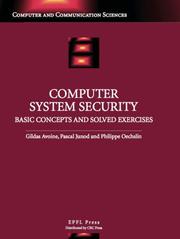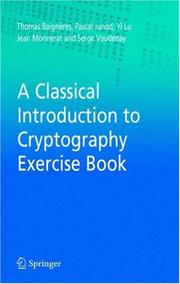| Listing 1 - 7 of 7 |
Sort by
|
Book
Abstract | Keywords | Export | Availability | Bookmark
 Loading...
Loading...Choose an application
- Reference Manager
- EndNote
- RefWorks (Direct export to RefWorks)

ISBN: 9781420046205 1420046209 9782940222148 2940222142 Year: 2007 Publisher: Lausanne : Boca Raton, FL. : EPFL Press, CRC Press
Abstract | Keywords | Export | Availability | Bookmark
 Loading...
Loading...Choose an application
- Reference Manager
- EndNote
- RefWorks (Direct export to RefWorks)
Computer networks are the spinal cord of our civilisation; because of the huge stakes involved, universities and certain companies must now teach the basics of computer system security. The purpose of this book is to help people learn about the fundamentals of this field through the study of solved exercices. The primary goal is not to create experts in this domain, but rather to teach the concepts required to understand the risks and consequences of computer system misuse. This book thus handles the basic aspects of computer security, including e-mail; viruses and antivirus programs; program and network vulnerabilities; fire walls, address translation and filtering; cryptography; secure communications; secure applications; and security management.This work is a novel addition to the literature in that it gives, for each subject, a short summary of the main principles followed by a series of exercises (with solutions), resulting in a self-contained book that provides a solid foundation in computer security to students. Chapters in this book have been conceived to be as independent as possible. All of them, nevertheless, require a background in computer science and a familiarity with the most common network protocols. [Publisher]
Computer security. --- Sécurité informatique --- Computer security --- Computer systems --- Data protection --- Systèmes informatiques --- Protection de l'information (informatique) --- Safety measures --- Mesures de sécurité --- Sécurité informatique --- Safety measures. --- Mesures de sécurité. --- Systèmes informatiques --- Mesures de sécurité.
Book
ISBN: 9782711748600 271174860X Year: 2010 Publisher: Paris : Vuibert,
Abstract | Keywords | Export | Availability | Bookmark
 Loading...
Loading...Choose an application
- Reference Manager
- EndNote
- RefWorks (Direct export to RefWorks)
Book
ISBN: 1607508435 6613433039 9786613433039 1607508443 1283433036 9781607508441 9781607508434 9781283433037 9781607508434 Year: 2011 Publisher: Amsterdam Washington, D.C IOS Press
Abstract | Keywords | Export | Availability | Bookmark
 Loading...
Loading...Choose an application
- Reference Manager
- EndNote
- RefWorks (Direct export to RefWorks)
The origins of linear cryptanalysis can be traced back to a number of seminal works of the early 1990's. Since its invention, several theoretical and practical aspects of the technique have been studied, understood and generalized, resulting in more elaborated attacks against certain ciphers, but also in some negative results regarding the potential of various attempts at generalization. This book gives an overview of the current state of the discipline and it takes a look at potential future developments, and is divided into five parts. The first part deals with basic assumptions in linear cry
Coding theory. --- Cryptography. --- Cryptography --- Ciphers --- Education --- Social Sciences --- Book Studies & Arts --- Ciphers. --- Codes --- Contractions --- Cryptanalysis --- Cryptology --- Secret writing --- Steganography --- Signs and symbols --- Symbolism --- Abbreviations --- Code names --- Writing --- Data encryption (Computer science) --- E-books
Book
ISBN: 9782711748341 2711748340 Year: 2004 Publisher: Paris : Vuibert,
Abstract | Keywords | Export | Availability | Bookmark
 Loading...
Loading...Choose an application
- Reference Manager
- EndNote
- RefWorks (Direct export to RefWorks)
Digital
ISBN: 9780387288352 Year: 2006 Publisher: Boston, MA Springer Science+Business Media, Inc
Abstract | Keywords | Export | Availability | Bookmark
 Loading...
Loading...Choose an application
- Reference Manager
- EndNote
- RefWorks (Direct export to RefWorks)
Ergodic theory. Information theory --- Computer science --- Computer architecture. Operating systems --- Information systems --- Computer. Automation --- coderen --- DES (data encryption standard) --- cryptografie --- cryptologie --- computerbesturingssystemen --- datacommunicatie --- programmatielogica --- OS (operating system) --- computernetwerken --- informatietheorie


ISBN: 9780387279343 9780387288352 0387279342 038728835X 9786610969425 1280969423 Year: 2006 Publisher: Boston, MA Springer Science+Business Media, Inc.
Abstract | Keywords | Export | Availability | Bookmark
 Loading...
Loading...Choose an application
- Reference Manager
- EndNote
- RefWorks (Direct export to RefWorks)
This companion exercise and solution book to A Classical Introduction to Cryptography: Applications for Communications Security contains a carefully revised version of teaching material. It was used by the authors or given as examinations to undergraduate and graduate-level students of the Cryptography and Security Lecture at EPFL from 2000 to mid-2005. A Classical Introduction to Cryptography Exercise Book for A Classical Introduction to Cryptography: Applications for Communications Security covers a majority of the subjects that make up today's cryptology, such as symmetric or public-key cryptography, cryptographic protocols, design, cryptanalysis, and implementation of cryptosystems. Exercises do not require a large background in mathematics, since the most important notions are introduced and discussed in many of the exercises. The authors expect the readers to be comfortable with basic facts of discrete probability theory, discrete mathematics, calculus, algebra, as well as computer science. Following the model of A Classical Introduction to Cryptography: Applications for Communications Security, exercises related to the more advanced parts of the textbook are marked with a star.
Computer security --- Cryptography --- 681.3*E1 --- 681.3*E3 --- 681.3*E4 --- Cryptanalysis --- Cryptology --- Secret writing --- Steganography --- Signs and symbols --- Symbolism --- Writing --- Ciphers --- Data encryption (Computer science) --- Computer privacy --- Computer system security --- Computer systems --- Computers --- Cyber security --- Cybersecurity --- Electronic digital computers --- Protection of computer systems --- Security of computer systems --- Data protection --- Security systems --- Hacking --- 681.3*E3 Data encryption: data encryption standard; DES; public key cryptosystems --- Data encryption: data encryption standard; DES; public key cryptosystems --- 681.3*E1 Data structures: arrays; graphs; lists; tables; trees --- Data structures: arrays; graphs; lists; tables; trees --- 681.3*E4 Coding and information theory: data compaction and compression; formal modelsof communication; nonsecret encoding schemes--See also {681.3*H11} --- Coding and information theory: data compaction and compression; formal modelsof communication; nonsecret encoding schemes--See also {681.3*H11} --- Protection --- Security measures --- Computer security. --- Cryptography. --- Sécurité informatique --- Cryptographie --- Problems, exercises, etc. --- Problèmes et exercices --- EPUB-LIV-FT LIVINFOR SPRINGER-B --- Data encryption (Computer science). --- Information theory. --- Computer Communication Networks. --- Data structures (Computer science) --- Coding theory. --- Data transmission systems. --- Cryptology. --- Theory of Computation. --- Data Structures and Information Theory. --- Coding and Information Theory. --- Input/Output and Data Communications. --- Information structures (Computer science) --- Structures, Data (Computer science) --- Structures, Information (Computer science) --- Electronic data processing --- File organization (Computer science) --- Abstract data types (Computer science) --- Data communication systems --- Transmission of data --- Digital communications --- Electronic systems --- Information theory --- Telecommunication systems --- Data compression (Telecommunication) --- Digital electronics --- Machine theory --- Signal theory (Telecommunication) --- Computer programming --- Communication theory --- Communication --- Cybernetics --- Data encoding (Computer science) --- Encryption of data (Computer science) --- Computers. --- Computer communication systems. --- Data structures (Computer science). --- Input-output equipment (Computers). --- Computer hardware --- Computer I/O equipment --- Electronic analog computers --- Hardware, Computer --- I/O equipment (Computers) --- Input equipment (Computers) --- Input-output equipment (Computers) --- Output equipment (Computers) --- Communication systems, Computer --- Computer communication systems --- Data networks, Computer --- ECNs (Electronic communication networks) --- Electronic communication networks --- Networks, Computer --- Teleprocessing networks --- Data transmission systems --- Information networks --- Telecommunication --- Cyberinfrastructure --- Network computers --- Automatic computers --- Automatic data processors --- Computing machines (Computers) --- Electronic brains --- Electronic calculating-machines --- Electronic computers --- Calculators --- Cyberspace --- Input-output equipment --- Distributed processing
| Listing 1 - 7 of 7 |
Sort by
|

 Search
Search Feedback
Feedback About UniCat
About UniCat  Help
Help News
News